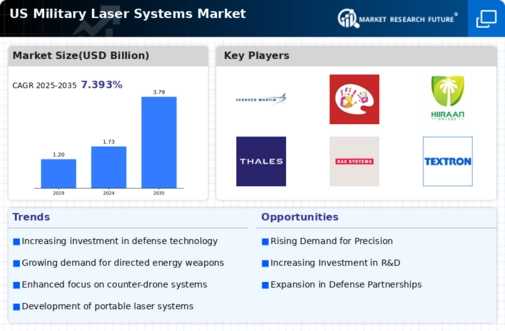Advancements in Laser Technology
The military laser-systems market is experiencing a surge due to rapid advancements in laser technology. Innovations in solid-state lasers and fiber lasers have enhanced the efficiency and effectiveness of these systems. For instance, the development of high-energy laser systems capable of delivering over 100 kW of power has been pivotal. This capability allows for precise targeting and engagement of aerial threats, which is increasingly vital in modern warfare. The US Department of Defense has allocated substantial funding, estimated at $1.5 billion in 2025, to further research and development in this area. As a result, the military laser-systems market is likely to expand significantly, driven by the need for more sophisticated and reliable defense mechanisms.
Enhanced Defense Against Emerging Threats
The military laser-systems market is driven by the need for enhanced defense against emerging threats, particularly in the realm of unmanned aerial vehicles (UAVs) and hypersonic missiles. As adversaries develop more sophisticated technologies, the US military is compelled to adopt advanced laser systems capable of countering these threats effectively. The ability of laser systems to engage multiple targets rapidly and with high precision makes them an attractive option for defense strategies. In 2025, The military laser-systems market is expected to grow by 20% from 2025 to 2035, driven by the urgency to protect critical assets and personnel from evolving threats. This focus on defense capabilities is likely to shape the future landscape of military engagements.
Strategic Partnerships and Collaborations
The military laser-systems market is benefiting from strategic partnerships and collaborations between defense contractors and government agencies. These alliances facilitate the sharing of knowledge, resources, and technology, which is essential for the development of cutting-edge laser systems. Notably, collaborations between the US Department of Defense and private sector firms have led to innovative solutions that enhance operational capabilities. In 2025, the market is projected to see a 10% increase in growth due to these partnerships, as they enable faster development cycles and more efficient deployment of military laser systems. This collaborative approach is likely to foster a more robust and responsive military laser-systems market.
Increased Focus on Cost-Effective Solutions
The military laser-systems market is increasingly focused on developing cost-effective solutions to meet budgetary constraints while maintaining operational effectiveness. As defense budgets face scrutiny, the demand for systems that offer high performance at lower costs is rising. Laser systems, which can provide a lower cost per engagement compared to traditional munitions, are becoming more appealing. The US military is exploring options that allow for sustained operational capabilities without excessive expenditure. In 2025, the military laser-systems market is anticipated to grow by 12%, driven by the need for affordable yet effective defense solutions. This trend indicates a shift towards more sustainable military operations.
Growing Demand for Precision Strike Capabilities
The military laser-systems market is witnessing a growing demand for precision strike capabilities. As military operations become more complex, the need for accurate and effective targeting systems has intensified. Laser systems provide a unique advantage by enabling pinpoint accuracy, which minimizes collateral damage and enhances mission success rates. The US military has recognized this need, leading to increased investments in laser-guided systems. In 2025, the market is projected to reach $3 billion, reflecting a compound annual growth rate (CAGR) of 15% over the next five years. This trend indicates a strong commitment to integrating advanced laser technologies into military operations, thereby driving the growth of the military laser-systems market.






















Leave a Comment